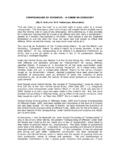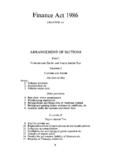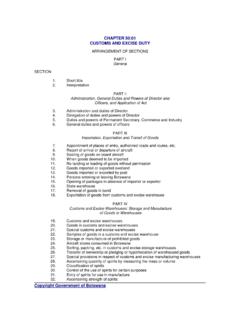Transcription of CAPTIVATING “CAPTIVE CONSUMPTION” - Central Excise
1 CAPTIVATING captive consumption (S. Jaikumar, G. Natarajan & M. Karthikeyan) We have received an interesting poser, which is the feedstock of this article. The query goes, as to whether the pallets, racks, trolleys, working tables etc falling under Chapter heading 73 of CENVAT Credit Tariff Act, 1944, which are fabricated inside the factory premises and used within the factory of production are entitled for the benefit of the Notification was also stated to us that, the assessee are manufacturing dutiable final products and the above said fabricated goods are used for inward movement of goods within the factory.
2 Before proceeding further, let us invite the readers attention to the Notification 67/95 CE, dated 16/03/1995. The said notification provides for exemption in respect of the following: 1. Capital goods as defined in the CENVAT Credit Rules, 2002 (sic 2004) manufactured in a factory and used within the factory of production. 2. Goods specified in Column (1) of the table hereto enclosed (herein after referred to as Inputs ) manufactured in a factory and used within the factory of production, in or in relation to the manufacture of final products specified in Column (2) of the said table.
3 It may be observed from the text of the above notification that, the exemption under Notification 67/95 is available for the two categories of goods Viz., 1. Capital goods defined in the CENVAT Credit Rules and 2. Specified goods under column (1) of the table to the said notification, which are used in the manufacture of goods specified under column (2) of the table to the said notification. Here, we pause to mention that, even though the term Inputs has been used in the said notification to represent the goods specified in Column (1) of the table, they do not correspond, in anyway, to the inputs as per the definition of the CENVAT Credit Rules.
4 In other words, the notification exempts, all capital goods as defined in CENVAT Credit Rules and all goods which are specified in Column (1) of the table to the said notification from payment of Excise duty, if they are manufactured in factory and used within the factory of production. Thus from the above, to qualify for the above said exemption notification, the following conditions need to be satisfied: Capital Goods: 1. They must satisfy the definition under CENVAT Credit Rules 2. They must be manufactured within the factory. 3. They must be used within the factory of production. All other Goods: 1. They must be specified under Column (1) of the table to the said notification.
5 2. They must be manufactured within the factory. 3. They must be used within the factory of production in or in relation to the manufacture of final products specified under Column (2) of the said table. 4. The final products are neither exempted from the payment of Excise duties nor chargeable to nil rate of duty save some specified clearances. It may be observed that in the present case, the impugned goods viz., pallets, trolleys etc., are classifiable under Chapter 73 of Central Excise Tariff Act, 1985 and hence are not defined capital goods under CENVAT Credit Rules. Thus, they do not qualify for the said exemption, as capital goods.
6 Now, it should be seen that whether they qualify for the exemption under the said notification as per clause 2 of the said notification. The said goods are (a) specified in Column (1) of the table to the said notification; (b) manufactured within the factory; and (c) used within the factory of production. Further the final products are neither exempted nor chargeable to nil rate of duty. Having satisfied the bulk of the conditions, now it has to be seen that whether the said goods are used in or in relation to the manufacture of final products. As the said pallets, trolleys, etc.
7 Are used for inward transportation of materials within the factory they can be well described as used in or in relation to the manufacture . In this connection, kind reference is drawn to the judgment in the case of M/s. TELCO Vs. CCE as reported in 1994 (70) ELT 75. Prior to coming into effect of the said Notification 67/95, similar exemption was granted by Notification 217/86, according to which, goods specified in Column (2) of the table annexed to the Notification 217/86 (referred to as inputs), manufactured in a factory and used within the factory of production, in or in relation to manufacture of final products specified in Column (2) of the table annexed to the Notification, were exempted from payment of duty.
8 By way of a proviso, it was stated that the term input shall not include machines, machinery, plant, equipments, apparatus, tools or appliances used for producing or processing of any goods or for bringing about any change in any substance or in relation to the manufacture of the final products. In that context, the benefit of the exemption was sought to be denied to gauges / measuring instruments / trolleys / tackles / conveyors / carriers, etc. manufactured by the appellant, in their factory of production, as they appeared to be covered under the exclusions contained in the proviso to the Notification.
9 After a detailed analysis, the Hon ble Tribunal came to a majority conclusion that, the impugned goods are not covered under the excluded items, in as much as, they neither take part in the manufacturing activity nor bring about any change in any substance. Accordingly, the subject goods have been held to be inputs for the purposes of the Notification. The above decision of the Hon ble Tribunal was affirmed by the Hon ble Supreme Court, as reported in 2003 (158) ELT 130 SC. In the instant case, the provisions of Notification 67/95, which are in pari materia to Notification 217/86, is under scrutiny.
10 Clause (ii) of the Notification 67/95 is worded akin to the provisions of Notification 217/86. The exclusion provided for under Notification 217/86 is conspicuously absent in Notification 67/95. Rather, there is an express inclusion of capital goods as defined in the Cenvat Credit Rules, in notification 67/95. The issue involved in the present case is identical to the one dealt in the above said TELCO case. As such, the ratio laid down in the said decision would amply vouch for the entitlement of exemption under Notification 67/95, for the subject goods. There is also a contra judgment to the above said conclusion in the case of CCE Vs Gajra Gears Limited 2004 (170) ELT 336.










